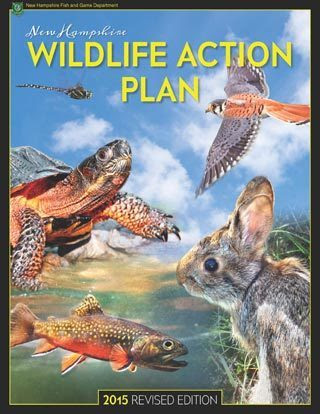 Dozens of scientists and more than 1,000 concerned citizens contributed to the updated New Hampshire Wildlife Action Plan, a 10-year blueprint for conserving nongame wildlife throughout the state. The updated New Hampshire Wildlife Action Plan will be unveiled at the annual conference of the New Hampshire Association of Conservation Commissions on November 7, 2015 at Pembroke Academy.
Dozens of scientists and more than 1,000 concerned citizens contributed to the updated New Hampshire Wildlife Action Plan, a 10-year blueprint for conserving nongame wildlife throughout the state. The updated New Hampshire Wildlife Action Plan will be unveiled at the annual conference of the New Hampshire Association of Conservation Commissions on November 7, 2015 at Pembroke Academy.
The New Hampshire Fish and Game Department recently sent the 1,600+ page plan to the US Fish and Wildlife Service for approval. The newly revised Wildlife Action Plan identifies species that are threatened or endangered, and shows a jump in species of greatest concern in New Hampshire from 118 in 2005 to 169 in 2015. Much of that increase is a result of greater knowledge gained about what rare species exist in the state and where, thanks to work guided by the first Wildlife Action Plan launched in 2006.
The new plan also highlights that habitat types most at risk in the Granite State include saltmarshes, warm water rivers and streams, dunes, lowland spruce-fir forest and vernal pools. In the ten years since the publication of the first Wildlife Action Plan in 2005, more than 230,000 acres of land that was identified as important habitat for protection in the Wildlife Action Plan has been conserved throughout the state.
Commercial and residential development, pollution, disease, and climate change are among the risk factors that impact the health of wildlife populations and habitats. As a part of the revision process, scientists identified where and how wildlife will be affected over the next ten years and what actions need to be taken to prevent further losses of the most vulnerable species and habitats.
The Wildlife Action Plan provides information, data and maps that state and federal agencies, municipalities, regional planners, universities and conservation organizations can use as they make decisions about land use, development and conservation.
“New Hampshire has made significant strides in ten years,” says John Kanter, Supervisor of the NH Fish and Game Department’s Nongame and Endangered Wildlife Program. “For example, we have made substantial progress toward the recovery of the endangered Karner blue butterfly, and we have played a leading role in the effort to protect the New England cottontail by restoring hundreds of acres of habitat and contributing to a successful captive breeding program. New research and survey efforts have laid the foundation for conserving Blanding’s turtle and other endangered and threatened reptiles.”
While wildlife in New Hampshire faces many new threats and challenges, there are also many opportunities ahead. The Wildlife Action Plan identifies 117 actions that span monitoring, research, species and habitat management, land protection, education and technical assistance. There are actions everyone can take to help protect wildlife in New Hampshire, from homeowners and educators to local commissions, non-profits and businesses. Says Kanter, “It is only through a broad-based, all-hands-on-deck approach that the state will continue to protect and manage species and habitat that improve our quality of life and economy.”
Glenn Normandeau, Executive Director of N.H. Fish and Game, says the plan is data-driven and the result of a tremendous group effort that will serve as a roadmap for future actions: “With so many outdoor enthusiasts in New Hampshire and a tourist economy that is fueled by beautiful natural areas, it is no surprise that so many people participated in the process of updating the plan. People in the Granite State are deeply concerned about protecting wildlife and the habitats that support them and their input was critical to updating the plan.”
Normandeau says the Wildlife Action Plan is one of the most cost-effective tools the state has to protect important wildlife and the habitats they need to survive. “The Wildlife Action Plan helps us coordinate efforts to both protect threatened and endangered species, as well as to keep common species common,” says Normandeau. “It’s far less expensive to protect the land and water that wildlife needs to thrive than it is to restore species and habitat once they’ve been lost.” As an example, Normandeau noted that conservation actions taken as a result of the first Wildlife Action Plan led to the USFWS decision this year not to list the New England cottontail as endangered.
“The updated Wildlife Action Plan is a crucial tool for us,” says Nik Coates, Executive Director of the New Hampshire Association of Conservation Commissions. “Conservation commissions and other organizations need to be strategic about where we focus our limited dollars. The plan has been and will continue to be instrumental in guiding us and providing critical data to make the right decisions.”
For more information about the 2015 New Hampshire’s Wildlife Action Plan, please visit www.wildnh.com/wildlife/wap.
